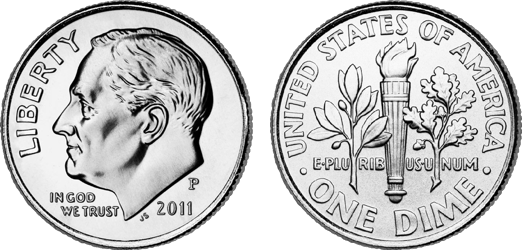Yesterday I walked past L'Acajou Café in Oakland, which inspired this puzzle.
Acajou is French for the tropical tree in the picture. What is the main food crop yielded by this tree?
The MIT International Students Office publishes a website with lots of useful information for newcomers to the US—things people born here take for granted that are far from obvious to the rest of the world. Topics include tipping in restaurants, American holiday customs, small talk—and, perhaps surprisingly, the value of a dime. Why does that last topic warrant discussion?
Solution
If you have traveled to just about any other country, you've probably been able to use the coins without thinking about it much; coins most places are labeled with their value in numerals. Not so in the US. The only indication a dime gives of its value are the words ONE DIME.

The other everyday coins also use words instead of numerals ("ONE CENT", "FIVE CENTS", "QUARTER DOLLAR"), but at least those words are less obscure; numbers are among the first words language learners pick up, while "dollar" is widely known, some form of "cent" is used in many countries, and it's common worldwide for the main currency to be divided into 100 parts.
"Dime" is originally from the Latin for one-tenth but is no longer used for anything but the currency. Oh, and there's the little matter of dimes being the smallest coin, which is not very intuitive.
The MIT website is quite interesting, whether you were born in the US or not!
Congratulations to yesterday's solvers Leo S., Anna K., Aditi, Alex Z., Ena, Peter M., Jacob C., and Mr. Gregg. Thanks to everybody who made a guess!
Though he now teaches mathematics, Dr. (né Mr.) Shapiro's first job in a K–12 school was as a lunch monitor in Davis, CA. It was there that he originated the Puzzle of the Day, even rewarding correct answers with tickets in denominations like "15 points" (though without a clear idea of how he'd ultimately redeem these). Dr. Shapiro's favorite puzzle from this pre-professional era was "Tell me the location of the beehive on this campus."
Ten years later, Dr. Shapiro revived Puzzle of the Day at Proof School, writing each day's puzzle on a name tag. After 600 puzzles or so, he was just starting to feel normal about students reading his chest all the time when campus closed and the puzzle, like the rest of our lives, moved online. New puzzles are posted daily on school days.
Want to catch up on old PotDs? There's an archive currently containing puzzles from March to December 2020.

